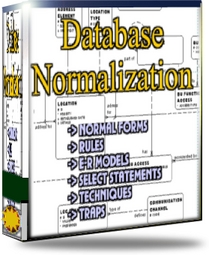
Furthermore, you will find that writing good DML-statements (SELECT, UPDATE, INSERT or DELETE) is difficult, and sometimes actually impossible, without using a lot of procedural coding (PL/SQL in Oracle, VB/C# in Microsoft products).
Many "experts" will tell you that if you do database normalization up to (and including) the Third Normal Form, you're well off. The Database Normalization eBook shows you that this a far too easy approach, and it is richly documented with graphical Entity Relationship and Server Diagram examples.
(you will find out that this is no big deal...)
Consistent examples
The Database Normalization eBook uses a consistent theme of accounts, departments, projects and transactions throughout, so you can easily review the consequences as we move from First Normal Form through all the accepted Normal Forms.Entity Relationship and Database diagrams
Pros and cons of denormalization with the aim of improving performance are also discussed, and which consequences denormalization may have on your database. The Database Normalization eBook is illustrated with more than 20 entity relationship diagrams, as well as database (server) models, and SELECT statements that use the model.Complete DDL scripts
The Database Normalization eBook includes complete DDL (Data Definition Language) scripts for creating the tables, indexes and constraints from the example database model in the eBook, for both Oracle and MS SQL Server. This will give you a view of the components that need to be created in order to build a fully normalized sample database.If you are serious about understanding how databases are designed for maximum performance and minimum (no) redundancy, then you should know the details of database normalization.
How to order
Within a few seconds after payment, you can start reading and discovering in detail about all the accepted Normal Forms in database modeling and design, translated into straight-forward English, understandable language.
60-Day, 100% unconditional money-back guarantee:











